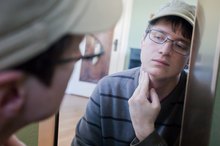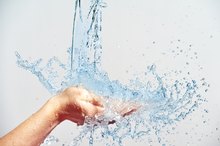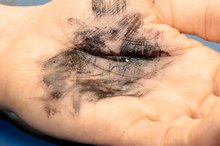How to Wash Bleach Off of Your Skin
Splashing a little bit of bleach on your skin probably won’t cause you any pain unless you’ve got a cut or open wound. Bleach will begin drying out your skin on contact, so it’s important to wash the chemicals off as soon as possible. Constant exposure to bleach can make you skin extremely dry, scaly, red and sensitive, according to Peter Helton, medical director of the Helton Skin and Laser Institute in Newport Beach, California 1.
Wash the affected area with clear water for 15 to 20 minutes. Splash fresh water gently against the skin and brush the area gently with your hand or a soft cloth. Don’t scrub the area.
Read more about the effects of bleach on skin and eyes.
How to Care for Sunburned Skin
Learn More
Continue washing the skin if, after 20 minutes of washing, you feel a slime-like texture on your skin where the bleach spilled. Keep refreshing the water to avoid washing the area in water contaminated with bleach.
Pat the skin dry after completely clearing the skin of bleach. Skin may feel unusually dry in the area touched by bleach.
How to Treat Cracked Skin on the Hands
Learn More
Apply a shielding lotion to your skin in the affected area. Unlike regular hand creams and oils, shielding lotions are formulated to be absorbed into the top layer of your skin. This will moisturize and seal your skin so you don’t lose additional moisture from the bleached area.
Read more about how lysol is toxic to humans.
Warnings
Bleach is corrosive. Do not get it in your eyes or on clothing. Call a physician immediately if your skin cracks, bleeds or blisters after contact with bleach.
Related Articles
References
- The National Skin Care Institute: Skin Care Tips, How To Beat Dry Skin
- Benzoni T, Hatcher JD. Bleach Toxicity. In: StatPearls [Internet]. 2019.
- Center for Disease Control and Prevention. Cleaning and sanitizing with bleach after an emergency. Health and Safety Concerns for All Disasters. 2017.
- Centers for Disease Control and Prevention. Infection Control: Chemical disinfectants. Updated September 18, 2016.
- Centers for Disease Control and Prevention. Cleaning and Sanitizing With Bleach After an Emergency.
- E. Rhinehart, M. Friedman, and M. McGoldrick. Infection Control in Home Care and Hospice. 2006. Association for Professionals in Infection Control and Epidemiology. Jones and Bartlett Publishers.
- Chopra R, Vakharia PP, Sacotte R, Silverberg JI. Efficacy of bleach baths in reducing severity of atopic dermatitis: A systematic review and meta-analysis. Ann Allergy Asthma Immunol. 2017;119(5):435-440. doi:10.1016/j.anai.2017.08.289
- Maarouf M, Shi VY. Bleach for Atopic Dermatitis. Dermatitis. 2018;29(3):120-126. doi:10.1097/DER.0000000000000358
- Fritz SA, Camins BC, Eisenstein KA, et al. Effectiveness of measures to eradicate Staphylococcus aureus carriage in patients with community-associated skin and soft-tissue infections: a randomized trial. Infect Control Hosp Epidemiol. 2011;32(9):872-80. doi:10.1086/661285
- Shi VY, Foolad N, Ornelas JN, et al. Comparing the effect of bleach and water baths on skin barrier function in atopic dermatitis: a split-body randomized controlled trial. Br J Dermatol. 2016;175(1):212-4. doi:10.1111/bjd.14483
- Chopra R, Vakharia PP, Sacotte R, Silverberg JI. Efficacy of bleach baths in reducing severity of atopic dermatitis: A systematic review and meta-analysis. Ann Allergy Asthma Immunol. 2017;119(5):435-440. doi:10.1016/j.anai.2017.08.289
- Sawada Y, Tong Y, Barangi M, et al. Dilute bleach baths used for treatment of atopic dermatitis are not antimicrobial in vitro. J Allergy Clin Immunol. 2019;143(5):1946-1948. doi:10.1016/j.jaci.2019.01.009
- Barnes TM, Greive KA. Use of bleach baths for the treatment of infected atopic eczema. Australas J Dermatol. 2013;54(4):251-8. doi:10.1111/ajd.12015
- Creech CB, Al-zubeidi DN, Fritz SA. Prevention of Recurrent Staphylococcal Skin Infections. Infect Dis Clin North Am. 2015;29(3):429-64. doi:10.1016/j.idc.2015.05.007
- Gittler JK, Wang JF, Orlow SJ. Bathing and Associated Treatments in Atopic Dermatitis. Am J Clin Dermatol. 2017 Feb;18(1):45-57. doi:10.1007/s40257-016-0240-2
Writer Bio
Kate Sheridan is a freelance writer, researcher, blogger, reporter and photographer whose work has appeared in numerous newspapers, magazines and trade publications for over 35 years. She attended Oakland University and The University of Michigan, beginning her journalism career as an intern at the "Rochester Eccentric." She's received honors from the Michigan Press Association, American Marketing Association and the State of Michigan Department of Commerce.









